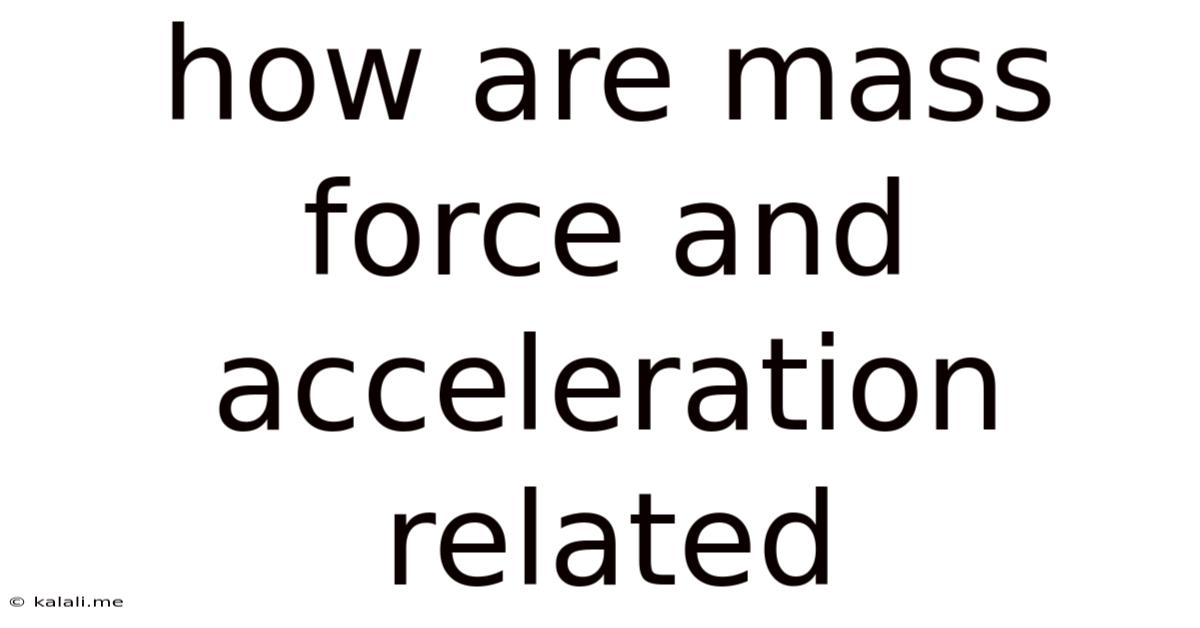How Are Mass Force And Acceleration Related
Kalali
Jun 13, 2025 · 3 min read

Table of Contents
How Are Mass, Force, and Acceleration Related? Understanding Newton's Second Law
Newton's Second Law of Motion is a cornerstone of classical mechanics, elegantly describing the relationship between mass, force, and acceleration. Understanding this relationship is crucial for comprehending how objects move and interact within our physical world. This article will delve into this fundamental principle, explaining the concepts involved and providing practical examples.
The Essence of Newton's Second Law: In simple terms, Newton's Second Law states that the acceleration of an object is directly proportional to the net force acting on it and inversely proportional to its mass. This means that a larger force will result in a greater acceleration, while a larger mass will result in a smaller acceleration for the same force.
The Mathematical Representation: This relationship is concisely expressed through the following equation:
F = ma
Where:
- F represents the net force acting on the object (measured in Newtons). This is the vector sum of all forces acting on the object. If forces are acting in opposite directions, you need to subtract them to find the net force.
- m represents the mass of the object (measured in kilograms). Mass is a measure of an object's inertia – its resistance to changes in motion.
- a represents the acceleration of the object (measured in meters per second squared). Acceleration is the rate of change of velocity.
Understanding the Components:
-
Force (F): A force is any interaction that, when unopposed, will change the motion of an object. Forces can be pushes, pulls, or even gravitational attraction. Examples include friction, gravity, tension, and applied forces. Understanding the different types of forces is key to solving problems involving Newton's Second Law.
-
Mass (m): Mass is a scalar quantity, meaning it only has magnitude and no direction. A heavier object (larger mass) requires a greater force to achieve the same acceleration as a lighter object. This directly relates to inertia; a more massive object resists changes in its motion more strongly.
-
Acceleration (a): Acceleration is a vector quantity, meaning it has both magnitude and direction. It describes how quickly the velocity of an object is changing. A positive acceleration means the object is speeding up, while a negative acceleration (also called deceleration) means it is slowing down. If the velocity is constant, then the acceleration is zero.
Practical Examples:
-
Pushing a shopping cart: The greater the force you apply (pushing harder), the greater the acceleration of the shopping cart. If you add more items (increasing mass), you'll need to apply a greater force to achieve the same acceleration.
-
A rocket launching: The immense force generated by the rocket engines overcomes the rocket's large mass, producing a significant upward acceleration.
-
A car braking: The braking force creates a negative acceleration (deceleration), slowing the car down. The braking force needed to stop a heavier car in the same distance is larger than that needed for a lighter car.
Beyond the Basics: Considering Multiple Forces and Vectors
In real-world scenarios, multiple forces often act on an object simultaneously. To apply Newton's Second Law accurately, you need to determine the net force – the vector sum of all forces acting on the object. This often involves resolving forces into their x and y components and then adding them vectorially. Understanding vector addition and resolution is crucial for solving more complex problems.
Conclusion:
Newton's Second Law (F = ma) provides a fundamental framework for understanding the relationship between mass, force, and acceleration. By grasping the concepts of force, mass, and acceleration, and by applying the equation correctly – including vector analysis where appropriate – you can accurately predict and explain the motion of objects in a wide range of scenarios. This simple yet powerful law underpins much of classical physics and remains essential for students and professionals alike.
Latest Posts
Latest Posts
-
What Is The Fine For Killing A Buzzard
Jul 01, 2025
-
How Old Am I If I Was Born In 1996
Jul 01, 2025
-
What Is 3 X 3 X 3
Jul 01, 2025
-
How Many Apples In A 3 Pound Bag
Jul 01, 2025
-
How Many Pounds Is A Bushel Of Peanuts
Jul 01, 2025
Related Post
Thank you for visiting our website which covers about How Are Mass Force And Acceleration Related . We hope the information provided has been useful to you. Feel free to contact us if you have any questions or need further assistance. See you next time and don't miss to bookmark.